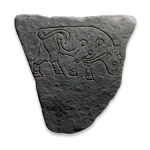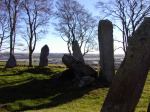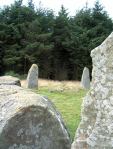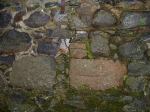February 2003 IMBOLC FoGS Newsletter volume XIV number 1
Pictish Cross-incised stone – Sacred setting threatened
PICTOPHILES are aware of accepted classification of carved stones of Eastern Scotland into groups denoting a rough time period and sculpting method:
Pictish ‘class I’ for incised carving, roughly dating to AD6-7thCC (some have suggested as early as 5thC) and ‘class II’ dating from Nechtan’s national initiative to convert his people to Christianity in the 8thC.
These stones are usually carved in relief with elaborate decorated panel infill reminiscent of the illuminated manuscript art of the period, notably from anglian Lindisfarne (which influenced Nechtan’s ‘romanizing’ campaign, deliberately separated from that of Iona).
‘Class III’ stones, usually showing mounted aristocracy plus cross art, are more numerous in Moray and Angus and less evident in Aberdeenshire, where a simpler style of conversion sculpture appears:
the plain incised cross, called ‘class IV’ by Isabel Henderson (‘Early Christian Monuments displaying crosses but no other Ornament’ in Alan Small’s The Picts: a new look at old problems Dundee 1987).
Where Aberdeenshire misses out on mounted horsemen, it certainly makes up in cross-incised ‘pillow-stones’, so called in literature of the time because of the monastic habit of sleeping with head on the cross and sometimes carrying these portable ‘pillows’ on pilgrimages of conversion.Crosses, both elaborate (rounded terminals) and simply incised, have been found at Fintray, Deer, Monymusk, Botriphnie, Tofthills Clatt, Culsalmond, Aboyne and Dyce. They are an important record of our earliest conversion as a Pictish nation, as well as a reminder of Aberdeenshire’s conservative approach to anything new! The most recently discovered cross-stone, however, found in the wall of an early 19thC steading at Kirkton of Bourtie, adjacent to Bourtie Kirk, 4m from Inverurie (newsletter Vol.XII-4, 2001)appears not to be important enough in the corridors of Historic Scotland to assign it the protection of ‘scheduling’ (private comm. FOGS/HS 2002).
The reason given is that the cross-stone, almost identical to another carved in similar pink granite and embedded in the Kirkyard wall a stone’s throw away, is
‘not in situ’ (HS quote) and ‘best way of preserving the stone is for it to be removed from the steading wall and to be deposited with most local museum.’
While professing to protect our most fragile heritage in situ, it seems the lumbering giant of bureacracy is poised to strike again, with little thought given to the sacred context or to local opinion. It is admittedly true that the ‘class IV’ cross-stones of Inverurie kirkyard disappeared after the Ministry of Works assumed charge of the cemetery post-WWII, but the Bourtie crosses are both embedded in structures associated with and meaningful to the Kirkton and as such are more likely to survive and be appreciated where they are than in a museum drawer.
The situation is marginally complicated by the fact that the steading owner is presently considering an application for planning permission to convert it for dwelling houses, but local planning/heritage (Gordon House, Inverurie) are well aware of its significance and are meticulous and dependable on ‘delicate’ issues.
Local MP/MSPs are investigating the illogical manipulation of stones of ‘national importance’ by HS, who also unfortunately have power over buildings (to ‘list’ or not to list).
Pictish and early-mediaeval historians such as Lloyd Laing and Nigel Pennick have written deploring this cavalier attitude by a government department, and magazines like Pictish Arts/ Northern Earth have featured the threat to the stone in recent editions.
However, if we do not stand up for our own heritage locally, a fate may befall it similar to that of the Pictish stones of Dyce (still in HS vault, unlikely to be returned until money is found to do up St Fergus church, Dyce).
As it stands, a ‘catch-22’ situation exists: because the stone has not been ‘scheduled’, HS has no power to remove it; but because it is not protected by ‘scheduling’, a non-heritage-minded councillor in committee is free to overrule planning for economic gain. May we ask those of you who scan local news to keep this little stone firmly in the forefront of your awareness and either write to planners at the appropriate time and/or write to your MP/MSP asking for a change in legislation at government level. Thank you.
FOGS ©MCY2003Sixth Dark Age Conference
THERE IS still time to register for the 6th Day Conference in this series to be held 22 February 2003 in the Purdie building University of St Andrews: ‘Landscape & Environment in Dark Age Scotland’, chair Barbara Crawford; send cheque (£15, conc.£12) to Dark Age Studies at Dept. of Medieval History, 71 South Street, St.Andrews KY16 9ALVenus, Jupiter as ‘morning stars’
WHILE scanning the heavens, as circle-watchers do, we are currently blessed with Jupiter as the brightest orb in the night sky; but while presently at its closest to earth (even with smallest telescope, its belts & 4 largest moons visible), the planet seems still more beautiful in pre-dawn sky when it is joined by the rising Venus (SE, with Jupiter setting in W).‘Crop Circle’ still there
FOLLOWING equinox item (VolXIII-3) on the man-made bale circle, it is pleasing to know both farmer Peddie and NE weather are cooperating in maintaining its position on this wild and exposed slope [NJ 801 249]. As a sculpture and reminder of how the original recumbent stone circle may have looked, its bales will remain until July when decisions to plant oil-seed rape will be made.Congratulations to Meyn Mamvro
SISTER stones-loving organization Meyn Mamvro, who take care of business in Cornwall and have been instrumental in putting pressure on authorities to do a better job with sacred stones in the SW, have reached their 50th issue. We commend them on their work of 16 years. http://www.meynmamvro.co.uk/
Recommended Books
OCCASIONALLY we suggest titles from a list of recent publications: the following are recommended by our book reviewers:Spynie Palace and the Bishops of Moray : history, architecture & archaeology by John Lewis & Denys Pringle 2002 ISBN 0-903903-21-0
Aberdeen: an in-depth view of the city’s past by Alison Cameron & Judith Stones 2001 ISBN0903-903-19-9 (both above are Soc.Antiqs monographs)
The Heirs of King Verica: culture & politics in Roman Britain by Martin Henig, Tempus 2002 ISBN 0-7524-1960-9.
Particularly interesting is his cultural commentary on Agricola, Mons Graupius (not a war historian).Elphinstone lecture
MEMBERS may be interested in a contribution to the Elphinstone Institute’s programme for 2003 to be held in the Regent Lecture Theatre, University of Aberdeen: 18 February, 7:30pm Dr Emily Lyle of School of Scottish Studies Univ Edinburgh ‘The Guidman’s Craft & other special Places & Times’ £2.












Recent Comments